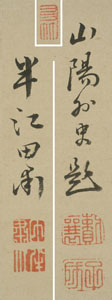Nanga
LandscapeSigned: Hankô Denshuku, San'yô gaishi
Seals: Denshuku Hankô, Rai Jô Shisei, Tomotake (tp)
Technique: sumi on paper 125.5 x 29.3
Mounting: decorated gold damask 190 x 42.5
Box: authorized 1924 by his grandson Rai Kiyoshi (1860-1929)
Condition: very good
午簾影滅送遥雷 / 一榻微風幽夢回 / 酒渇思茶茶未熟 / 愛聞琴筑遶檐来。
Afternoon: the bamboo curtain obscures the light, the sound of thunder in the distance.
On the couch, a light breeze awakens me from sad dreams.
My thirst after my drinking begs for tea, but it has not been made yet.
I wish to hear music from the koto that echoes around the eaves.
Poem included in the collection San’yō shishō, 山陽詩抄
Hankô was considered the foremost bunjinga artist of his time. He was a native of Osaka and the son and pupil of the well-known painter Okada Beisanjin (1744-1818). Like his father Hankô served lord Tôdô of Tsu as a minor official at the clan’s rice warehouse in Osaka. Hankô resigned at the age of thirty-nine in favour of his son. He joined the intellectual circles of Osaka and started travelling as a bokkyaku (‘ink guest’, exchanging paintings for hospitality).
He was befriended with other important bunjin like Rai San'yô, Tanomura Chikuden (1777-1835), Shinozaki Shôchiku (1781-1851) and Uragami Shunkin (1779-1846).
Reference:
Roberts p.38
Araki p. 498
Rosenfield B 73 (# 171-172)
Cahill p. 108 (# 53)
Addiss '76 p. 162 (# 62)
San’yô was born in Osaka when his father was teaching there. He came from an intellectual family; his father Rai Shunsui (1746-1816) was the Confucian teacher to the daimyô of Aki. San’yô’s grandfather studied Japanese poetry, his uncle Rai Kyôhei (1756-1834) was a Confucian and advisor to the Aki domain, and his mother, Rai Baishi (1760-1843), was a poet in Chinese and a scholar. Originally the family were rich merchants from the Hiroshima region.
When they returned from Osaka to Aki San’yô went to school at the age of nine. He excelled in both martial and cultural studies. In 1797 he accompanied his uncle Kyôhei to Edo and became student at the Shôheikô, the official Confucian academy. After his return a year later he was forced into a marriage that immediately collapsed. He went to Kyoto, where he ruined his life. Subsequently, his family ordered him home and put him into house arrest. After his release in 1803 he was still working on Nihon gaishi, ‘his’ history of Japan, which he finished in 1827. Five years after his death it was printed and it became a bestseller in the Meiji restoration. In 1805 he became a teacher from which job he resigned in 1811, after which he traveled Japan as a bunjin bokkaku, ink-guest. He went to Osaka to study with the poet Shinozaki Shôchiku (1781-1851) and in 1818 he traveled to Hiroshima and Nagasaki with Taigan. Back in Kyoto he joined a conservative group of Neo-Confucians exalting old Japanese values. San’yô was a most important pivot in the bunjin network.
Reference:
Rosenfield ’99 B.75
Hempel p. 168 ff.
Roberts p. 138
Araki p. 149
Price: ON REQUEST

